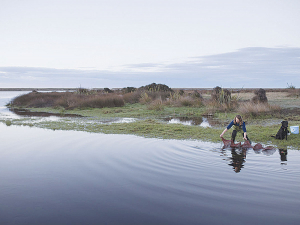Fonterra shaves 50c off forecast milk price
Fonterra has dropped its forecast milk price mid-point by 50c as a surge in global milk production is putting downward pressure on commodity prices.
 Fonterra hopes the project will help farmers adopt biodiversity objectives into their Farm Environmental Plans and support wider catchment biodiversity goals in the process.
Fonterra hopes the project will help farmers adopt biodiversity objectives into their Farm Environmental Plans and support wider catchment biodiversity goals in the process.
A new project supported by Fonterra's Living Water Partnership with the Department of Conservation will help on-farm advisors grow their understanding of biodiversity, with a view to further building biodiversity objectives into Farm Environment Plans.
'Farming with Native Biodiversity' is a 20-month project coordinated by the NZ Landcare Trust and funded by the National Bioheritage Science Challenge, Living Water, Silver Fern Farms and the Ministry for Primary Industries (MPI).
Protecting and restoring native biodiversity on farms provides clean water, shelter, shade, carbon sequestration, drought resilience and other benefits of a healthy ecosystem.
The Living Water partnership has identified that the biggest barriers to the protection and restoration of biodiversity on farms is limited access to advice and ecological expertise, along with the cost of preparing restoration plans.
"There is widespred interest from farming communities and farm advisors to protect and restore native biodiversity on farms, though expert advice is hard to come by and costly," says Trish Kirkland-Smith, Fonterra's head of environmental partnerships.
Development of a farm biodiversity restoration and management plan can cost between $5,000 - $10,000, with additional costs for monitoring.
Across 25,000 pastoral farms in New Zealand, this is over $125 million for the planning alone.
"This new partnership project trials a more cost-effective way of providing expert advice to the sector, working with over 60 sheep and beef and dairy farms to develop biodiversity plans and implement biodiversity management, then sharing the results with 6,000 more sheep and beef farms and 9,000 dairy farms.
"There is widespread interest from farming communities and farm advisors to protect and restore native biodiversity on farms, though expert advice is hard to come by and costly."
The expected outcome of the project is that farmers adopt biodiversity objectives into their Farm Environment Plans and support wider catchment biodiversity goals in the process.
For Fonterra suppliers, these biodiversity plans will become a part of their existing Farm Environmental Plans, which Fonterra provides to farmer owners free of charge.
It's not often that mother and daughter share the limelight, but for two of Tahuna's Charbelle Holsteins' show cows, that's exactly that happened at the Holstein Friesian North Island Champonships, held at the Waikato A&P Show.
Fonterra Edendale has been recognised with the Mars Dairy Supplier Quality Award for the top performing supplier sites in the global food company's dairy supply chain.
Sheep milk processor Maui Milk has achieved grass-fed certification of milk supply against the AsureQuality Grass-Fed Scheme.
OPINION: What goes up must come down. So, global dairy prices retreating from lofty heights in recent months wouldn’t come as a surprise to many farmers.
Fonterra directors and councillors are in for a pay rise next month.
Federated Farmers says it is cautiously welcoming signals from the Government that a major shake-up of local government is on its way.